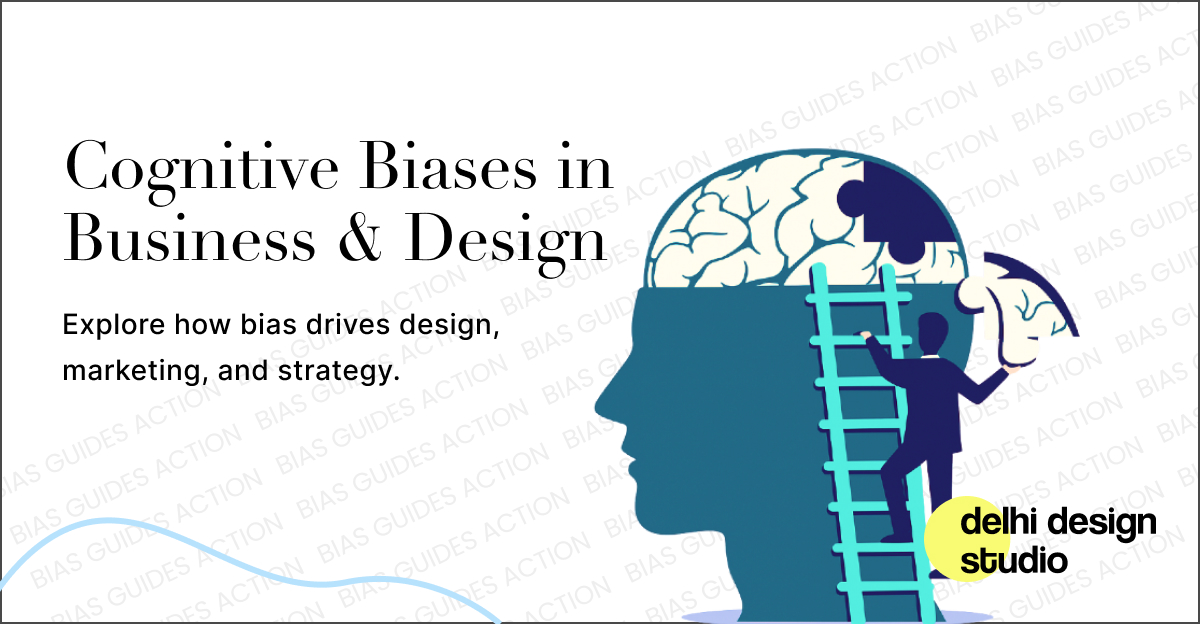
Cognitive Biases in Business & Design
How hidden biases influence choices in business and design.
In a world where branding, marketing, and design decisions can impact everything from conversion rates to customer trust, logic alone isn’t enough. Even the most experienced professionals fall prey to mental shortcuts called cognitive biases—subconscious errors in thinking that affect how we see, feel, and act.
At Delhi Design Studio, we believe that truly effective design is bias-aware design. By understanding how people think, we help brands across the globe make smarter decisions, build meaningful customer connections, and grow with confidence.
Let’s explore the 13 most common cognitive biases, real-world examples, and how they impact design, branding, and business outcomes.
🧠 1. Confirmation Bias
We seek information that supports our beliefs and ignore the rest.
Example: A startup founder only listens to positive customer feedback about their website, ignoring analytics showing a high bounce rate.
Fix: Assign a devil’s advocate in design discussions and test multiple viewpoints with real users. At Delhi Design Studio, we use UX research to uncover blind spots and hidden truths.
🧠 2. Anchoring Bias
We rely too heavily on the first piece of information we receive.
Example: A client hesitates to approve a budget because they previously saw a freelancer's low quote—regardless of the professional scope required.
Fix: Use value-based pricing and transparent benchmarks. Our team educates clients on ROI and long-term value over initial figures.
🧠 3. Availability Heuristic
We judge likelihood based on how easily examples come to mind.
Example: A brand refuses to use email marketing because they once received spam—but email is still one of the highest-converting channels.
Fix: We back up strategy with global data, performance metrics, and behavioral insights.
🧠 4. Sunk Cost Fallacy
We keep investing in a failing project because we’ve already put time/money into it.
Example: A team refuses to drop a failing app feature because of the cost invested in developing it.
Fix: Ask: “If we hadn’t built this, would we build it today?” Our product and UX audits help clients realign with what users truly need.
🧠 5. Dunning-Kruger Effect
Inexperienced people overestimate their abilities, while experts often underestimate theirs.
Example: Someone designs their own logo thinking it's “good enough,” without realizing the impact of strategic branding on perception.
Fix: At Delhi Design Studio, we provide clarity on what great design achieves—user trust, higher conversions, and lasting value.
🧠 6. Framing Effect
How information is presented changes how we interpret it.
Example: "90% fat-free" sounds better than "10% fat," even though they mean the same.
Fix: We use UX writing, copy psychology, and storytelling design to ensure your message lands powerfully and truthfully.
🧠 7. Halo Effect
We let one positive trait affect how we see unrelated qualities.
Example: A stylish website makes a brand seem more trustworthy—even if service is poor.
Fix: We balance aesthetics with functionality and substance—ensuring beauty supports credibility.
🧠 8. Recency Bias
We place too much weight on recent events.
Example: A manager over-praises a design just because it was well received last week, ignoring prior underperformance.
Fix: We review performance over time using heatmaps, analytics, and structured feedback loops.
🧠 9. Self-Serving Bias
We take credit for wins, but blame others for failures.
Example: A manager credits themselves for a campaign’s success but blames the design team when it underperforms.
Fix: We promote collaborative, data-informed processes where everyone owns both wins and lessons.
🧠 10. Bandwagon Effect
We follow trends just because others do.
Example: A brand redesigns just because competitors did—without clear reasoning.
Fix: We ask clients: “Would this still make sense if no one else was doing it?” Trend-aware, but strategy-first.
🧠 11. Optimism Bias
We underestimate risk and overestimate success.
Example: A new ecommerce site skips UX testing, assuming “it’ll work.”
Fix: We help clients stress-test concepts using prototypes, user flows, and scenario modeling.
🧠 12. Negativity Bias
Negative feedback has more emotional impact than positive.
Example: One bad review gets more attention than 50 positive ones.
Fix: We offer reputation management design and storytelling strategies to spotlight brand consistency and trust.
🧠 13. Endowment Effect
We overvalue things just because we own or built them.
Example: A founder won’t update their self-made logo—even if users find it confusing.
Fix: We ask: “Would you pay for this today if you didn’t already own it?” Then we show objective alternatives.
What We Offer at Delhi Design Studio
A global creative powerhouse, Delhi Design Studio blends design thinking, behavioral psychology, and technology to build brands that thrive across borders.
Our Services Include:
No matter where your audience lives—New York, Dubai, Singapore, London, or Tokyo—we design with global relevance and local impact.